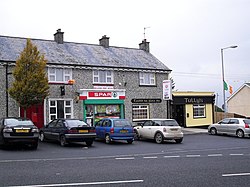Belleeks
| Belleeks | |
| County Armagh | |
|---|---|
 Belleeks Post Office | |
| Location | |
| Grid reference: | H987272 |
| Location: | 54°10’0"N, 6°28’60"W |
| Data | |
| Population: | 375 (2011) |
| Post town: | Newry |
| Postcode: | BT35 |
| Dialling code: | 028, +44 28 |
| Local Government | |
| Council: | Newry, Mourne and Down |
| Parliamentary constituency: |
Newry and Armagh |
Belleeks is a small village and townland in the south of County Armagh, by the Ring of Gullion in the south of the county. The 2011 Census recorded a population of 375.
The village lies within Barony of Upper Fews. Its name is from the Irish Béal Leice, meaning 'ford-mouth of the flagstone.[1]
Contents
Location
Belleeks lies between the villages of Camlough and Newtownhamilton, abreast the A25 between the Newtownhamilton and Newry. The nearest large town is Newry, approximately 7 miles to the east and Whitecross is the nearest settlement approximately 2 miles to the north. Belleeks lies in the townland of Belleeks Lower.
Features and economy
St Lawrence O'Toole's Roman Catholic Church sits in a prominent location above the village whilst a Church of Ireland church and Orange Hall stand between Belleeks and Whitecross. The village has two public houses, a small store, a part-time factory and a public common in the village centre. The village has developed from a linear settlement along the A25 as late as the 1960s with the addition of five private and local authority housing developments since the 1970s.
Most residents work away from the village. The largest local industry remaining is agriculture.
Sport
- Gaelic Athletics: Laurence O'Toole's GAA (Cumann Lorcáin Uí Thuathail), which competes in underage and senior men's and ladies' Gaelic football as well Scór and other Armagh GAA competitions. The clubhouse is located in Shaughan in the townland of Belleeks Upper.
History
Early history
The area in which Belleeks is situated has been populated for many thousands of years but contains less in terms of easily discernible pre-historic remains than is widely evident in other parts of south County Armagh. What was to become the village of Belleeks was once the site of a Tudor garrison, besieged and taken during the Nine Years' War, or 'Great O'Neill's rebellion'. The area which was to become the village was held in the estates of Hugh Boy O'Hanlon in 1641, one of the few Roman Catholic gentry retaining substantial landholdings in County Armagh following the Plantation of Ulster. However the Irish Rebellion of 1641 unseated the O'Hanlons.
Thee village was within the estates of the Earls of Gosford by the eighteenth century, and the modern settlement largely owes its origins to the then current earl, who, in the 1790s created a planned village on the site. Prior to the Irish Land Acts, the Earls of Gosford retained a large deer park on the outskirts of the village, who's impressive 18th century walls still bound the settlement to the east.[2]
Before the 20th Century
By the early 19th century, a hamlet had developed at Belleeks along the Newtownhamilton-Newry road which branches off to Whitecross at Belleeks, Indeed, in February 1767 Sir Archibald Acheson was granted a patent to hold fairs in the village on the 3rd days of February, May, August and November every year, all bar which the February fair survived up until 1852.[3]
Census returns for the period between 1841 and 1851, during which the Great Famine occurred, show a decrease in population of the village and surrounding area greater than one quarter of population in the ten-year period due to death and emigration.[4] During the 19th century, however, the settlement acted as the commercial centre for the surrounding region, with residents of outlying districts and nearby villages bringing butter, cheese, and other produce to Belleeks for sales and export to Belfast, and beyond.
Outside links
References
- ↑ Bell - Placenames NI
- ↑ Mulligan, K. The Buildings of Ireland: South Ulster Yale University Press, 2005, p. 191
- ↑ Crawford, W.H., Evolution of Towns in County Armagh, in Hughes, A.J. & Nolan, W. (2001): Armagh - History & Society Geography Publications, Dublin, p. 861
- ↑ Grant, J., Some Aspects of the Great Famine in County Armagh, in Hughes, A.J. & Nolan, W. (2001): Armagh - History & Society Geography Publications, Dublin, p.840